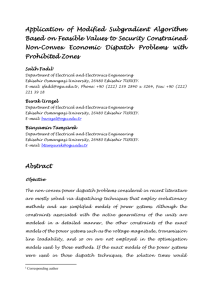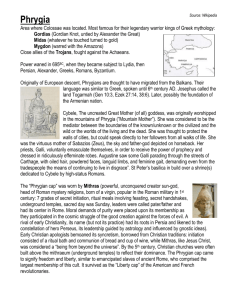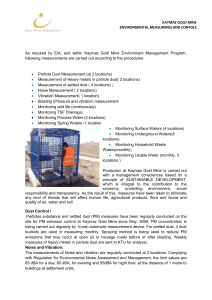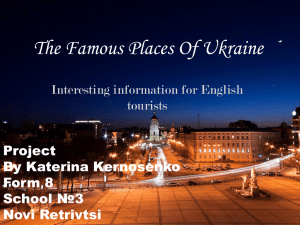Eskisehir
advertisement
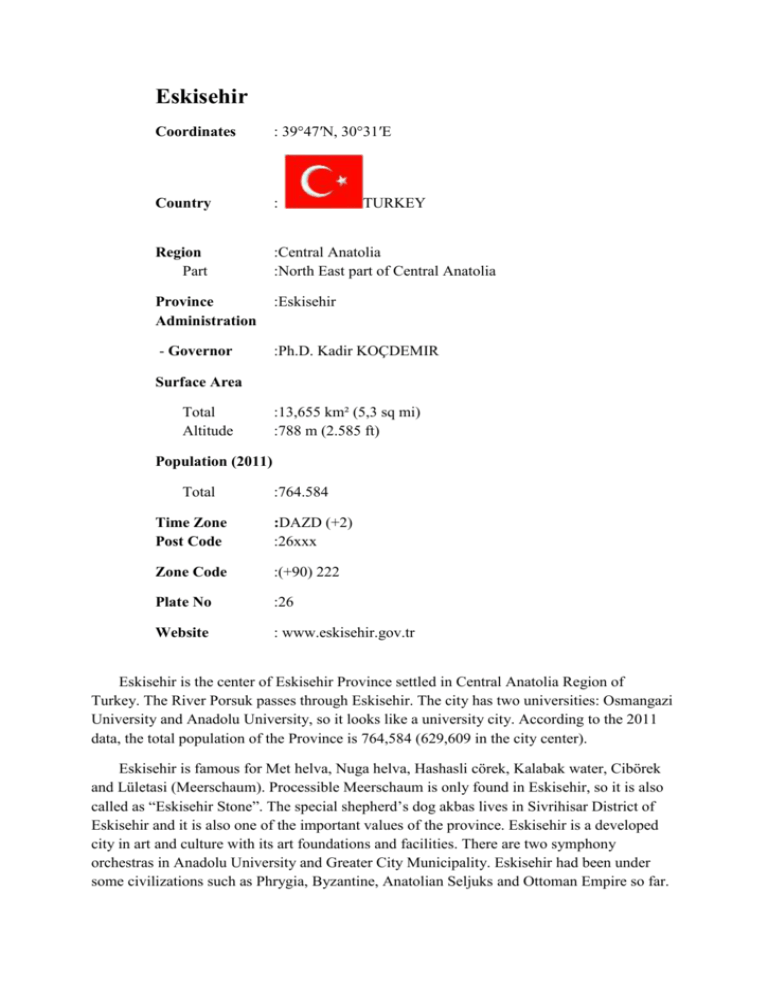
Eskisehir Coordinates : 39°47′N, 30°31′E Country : Region Part :Central Anatolia :North East part of Central Anatolia Province Administration :Eskisehir - Governor :Ph.D. Kadir KOÇDEMIR TURKEY Surface Area Total Altitude :13,655 km² (5,3 sq mi) :788 m (2.585 ft) Population (2011) Total :764.584 Time Zone Post Code :DAZD (+2) :26xxx Zone Code :(+90) 222 Plate No :26 Website : www.eskisehir.gov.tr Eskisehir is the center of Eskisehir Province settled in Central Anatolia Region of Turkey. The River Porsuk passes through Eskisehir. The city has two universities: Osmangazi University and Anadolu University, so it looks like a university city. According to the 2011 data, the total population of the Province is 764,584 (629,609 in the city center). Eskisehir is famous for Met helva, Nuga helva, Hashasli cörek, Kalabak water, Cibörek and Lületasi (Meerschaum). Processible Meerschaum is only found in Eskisehir, so it is also called as “Eskisehir Stone”. The special shepherd’s dog akbas lives in Sivrihisar District of Eskisehir and it is also one of the important values of the province. Eskisehir is a developed city in art and culture with its art foundations and facilities. There are two symphony orchestras in Anadolu University and Greater City Municipality. Eskisehir had been under some civilizations such as Phrygia, Byzantine, Anatolian Seljuks and Ottoman Empire so far. SUBJECT TITLES 1. ETYMOLOGY 2. HISTORY 2.1 Dorylaion 2.2 Midaion- Midas City 2.3 Roots of Greek and Roman Civilization 2.4 Religious Centre of Phrygian Civilization: Yazilikaya 2.5 The Phrygian Cap 2.6 Mother Goddess Cybele 2.7 Phrygian Inscriptions 2.8 Yazilikaya Platform 2.8.1. Phrygian Fortresses 2.8.2 The Uncompleted Monument 2.8.3 Monument with plant motifs (Hyacinth Monument) 2.8.4 Bahseyis Monument 2.8.5 Gerdekkaya Tomb Monument 2.8.6 Little Yazilikaya 2.9. Ottoman Empire was founded in Karacahisar 2.10 Eskisehir during the Independence War 2.11. Odunpazari Houses 3. GEOGRAPHY 3.1. Climate 3.2. Population 3.3. Underground Treasures 3.3.1. Kalabak Water 3.3.2. Meerschaum 3.3.3. Chalcedony Stone 3.3.4. Boron Mine 3.3.5. Thermal Resources 4. TRANSPORTATION 4.1. High Speed Train 4.2. Distances to the Important Cities 4.3. Transportation in City Center 5. ECONOMY AND INDUSTRY 5.1. Media 6. CULTURE AND ART 6.1. Theatres of Eskisehir 6.2. Haller Youth Centre 6.3. Museums of Eskisehir 6.3.1. Ataturk and Culture Museum 6.3.2. Ottoman House Museum 6.3.3. Glass Arts Museum 6.4. Traditional Hand Crafts 6.4.1. Sorkun Pottery 6.5. Traditional Cuisine 7. TOURISM 7.1. HISTORICAL PLACES 7.1.1 Kursunlu Mosque and Complex of Buildings 7.1.2 Seyyid Battal Gazi Turbah and Complex of Buildings 7.1.3. Sheikh Edebali Tomb 7.1.4. Sheikh Sahabettin Tomb 7.1.5. Yunus Emre Kulliye and Tomb 7.1.6. The house of Nasreddin Hodja 7.1.8. Alemsah Kumbeti 7.1.9 Ulucami (Emineddin_i Mikail Mosque) 7.1.10 The City Pessinus 7.2. Picnic Areas 7.2.1. Sakarya Basi 7.2.2. Balik Dami 7.3. Hunting And Fishing 8. EDUCATION 8.1. Primary Education 8.2. Secondary Education 8.3. Universities 8.3.1. Anadolu University 8.3.2. Eskisehir Osmangazi University 9. HEALTH INSTITUTIONS 10. SPORTS 10.1. Inonu Hang Glider and Parachute Camp 10.2. Eskisehirspor 11. LOCAL ADMINISTRATION 11.1. Administrative Management 11.2. Sister Cities 12. RESOURCES 1. ETYMOLOGY The first settlement in Eskisehir (Dorylaion) took place on 3500 B.C. The city had been under the reign of Hittites, Phrygians, Persians, Romans, Byzantines, Seljuks and Ottomans. Eskisehir was founded by Phrygians in 1000 BC as a basic settlement at the banks of the Porsuk River. The city is located at a major crossroad in Turkey. 2. HISTORY 2.1 Dorylaion The Sarhöyük- Dorylaion Tumuli is as high as a large hill. Its diameter is 450 m and it is 18 m higher than the plain. Cylix implements, Roman glass, metal fragments and bullet shells from the National Independence War were collected from this area. Such interesting antique discoveries as sixteenth century Ottoman ceramics, Byzantine pieces, artifacts from Roman, Hellenistic and the entire Phrygian culture were found in this area. The Hittite and Assyrian Colony Period findings are parallel to those found at Kültepe in Central Anatolia, and those from the Early Bronze Age; that is to say, evidence from the third millennium has been observed in this area. 2.2 Midaion- Midas City The Porsuk Valley is in the neighborhood of Karahöyük, next to the Porsuk River and on the fertile Alpu plain. Surface surveys, conducted by Ass. Prof. Nejat Bilgen proves that there has been a continuous settlement in this area since the Early Bronze Age. The city had coins minted in Roman Period. Abutments built in the same period were unearthed in excavations carried out by Eskisehir Archeology Museum. Tumuli bearing the name of king Midas are important. Phrygian King Midas is the most famous king from the legend. His wish, “Whatever I touch should turn to gold”, was accepted, but touching his daughter, he became regretful. In another legend, Apollon who did not like Midas’ refereeing in a music composition creating and performing by himself and Pan punished Midas and gave him donkey ears. In another Midas legend, his daughter suffered from a skin ailment. After her treatment in thermal waters and subsequent recovery, he had baths built in the environs of Dorylaion. 2.3 Roots of Greek and Roman Civilization Phrygians who dominated the region after the collapse of the Hittite Empire, around 1200BC, created a glamorous civilization. Besides being an agricultural society in general, stock farming was also quite developed, and the Phrygians were known as “a noble society breeding noble horses” by other societies. They produced original craft work such as carpentry, furniture-making, gold and silver embroidery, fibula (safety pins) and flute. In addition to all these, they formed the roots of the Greek and Roman Civilizations to come, with their music, architecture and sculpture. 2.4 Religious Centre of Phrygian Civilization: Yazilikaya The Yazilikaya Ruin, suggested for addition to the “World Cultural and Natural heritage List”, is without comparison anywhere in the world. The Phrygians, who constructed important buildings in the region, chose the ancient city of Yazilikaya as a religious centre. Yazilikaya is in the Yazilikaya Village of Han. It was a settlement on a rocky platform in the Early Bronze Age. There are also rock reliefs belonging to the Hittites and, although the society was affected by the forces of nature. Fortress walls, settlement areas, rock reliefs rock monuments, water cisterns, altars, snow fences, rock graves, stepped monuments, niches and ancient roads belonging to Phrygian Culture managed to survive to the modern era. The Phrygians who believed that their goddess lived on bare rocks, conducted their religious ceremonies in front of rocks decorated as a temple. Yazilikaya, one of the most important rock monuments in the world, at a height of 17 meters on the eastern slopes of the Yazilikaya platform, was devoted to the mother goddess Cybele on behalf of King Midas by the Phrygians. 2.5 The Phrygian Cap Bust of Attis were wearing a Phrygian cap. The Phrygian cap is a soft, red, conical cap with the top pulled forward. It was worn during antique times by the inhabitants of Phrygia, a region of Central Anatolia. In paintings and caricatures, it represents freedom and the search for liberty. The Phrygian cap that was known to be worn by King Midas to hide the donkey ears was given to him as a curse by Apollo. Its origin dates back to the Phrygians. 2.6 Mother Goddess Cybele Cybele, called Kubaba by the Hittites, was the mother goddess in Anatolia since Neolitic and Chalcolithic periods. She was the goddess of nature, mountains and animals, dominator of cities and agriculture and protector of young girls. Cybele was the sole goddess of Anatolia. Phrygians called her Agdistis. The Phrygians are known to have adopted Anatolian culture through Cybele cult, and this has influenced Roman religion. According to divination, the war between the Carthaginians and the Romans caused Roman fatigue and disappointment and, in order to defeat Carthaginians, the mother Cybele idol had to be brought to Rome from Pessinus, the religious centre of the period. The Roman armies defeated the armies of king Hannibal and Carthage after the Cybele idol had been taken to Rome along with Phrygian priests on 4th April 204 BC. 2.7 Phrygian Inscriptions The early Phrygian period inscriptions are found densely in Yazilikaya Phrygian Valley. Phrygian inscriptions are known to have been developed from the Phoenician alphabet, and influenced the Greeks when creating their alphabet. It was found that Phrygians played an important role in the spread of the Phoenician alphabet to the west. Early Phrygian Period inscriptions have not been fully deciphered yet. 2.8 Yazilikaya Platform 2.8.1. Phrygian Fortresses Phrygian fortresses, where the noble military class lived, are heaped on the rocks in this region. Most of these were built strategically on hillsides, and all of the characteristic details of Phrygian Rock buildings (ramparts with crenel holes engraved on rocks, fortress entrances, hidden steps, important passages and suchlike) are features of these fortresses. Although they saw some changes from their original use in the Hellenistic, Roman and Byzantine Periods, Phrygian fortresses have survived until today. 2.8.2 The Uncompleted Monument This monument is situated on the western slopes of the Ancient Yazilikaya Platform. Leaving uncompleted, it gives clues of Phrygian working methods in the building of monuments. It is understood that the rock were engraved from the top to the bottom, without using any scaffolding to build the monuments. Different from other rock monuments, its facing west is additionally important. Niches that constitute the base of this Phrygian monument were not engraved on the surface since it was uncompleted; however, it was engraved on its bottom left side. There is a lotus-pelmets motif on its frizz. Phrygian wooden architecture was imitated, and all such details were engraved on the rock monument. Gables and Niches and the form of a door are the main characteristics of the monument. 2.8.3 Monument with plant motifs (Hyacinth Monument) This monument on the eastern slopes of the Yazilikaya Platform is called the Hyacinth Monument in archeology due to its stylized acroterium with plant motifs on it. Swastika motifs on it attract attention. Different from the other monuments, it has nothing more than a niche under the gable, which emphasizes the religious significance of niches for the Phrygians. 2.8.4 Bahseyis Monument This monument is in Gökbahce Village in Seyitgazi. The rock is engraved in a threedimensional way. A cavity in the middle of the door niche meets with a cavity opening to the upper part of the monument. This characteristic helps us to understand that it was a liquid alter (fountain monument) and a “Cult Monument” 2.8.5 Gerdekkaya Tomb Monument This monument is located in Seyitgazi, Cukurca Village. It has the shape of a temple with two columns of the Doric Architectural style in Greek architecture. It is dated back to the Hellenistic Period. The monument was restored by Eskisehir Archeology Museum in 1991. 2.8.6 Little Yazilikaya This is located 2 km from Yazilikaya Village to the North and 100 m from the YazilikayaCukurca Road to the west. It is named “Little Yazilikaya” due to the Phrygian inscriptions on the upper side of the monument. Although it was not completed, an absolute niche was engraved on the monument due to the belief that the goddess Cybele was always watching over the Phrygians. 2.9. Ottoman Empire was founded in Karacahisar Osman, the son of Ertugrul Gazi from the Kayi tribe of Oghuz Turks declared his “Beylik” (his own state) in KARACASEHIR/KARACAHISAR where the foundation centre of Ottoman Sovereignty was based and which lasted six hundred years over three continents. Seljuk Sultan Alaaddin KAYQUBAT III recognized the “Beylik” of Osman, the conqueror of Karacahisar, by sending him a flag, a drum and a horse tail.The first Khuthbah, read in the name of Osman Bey in Karacasehir Mosque by Dursun Fakih, is recognized as the foundation of the Ottoman Empire. Sultanönü Province was the first province. “Bacs” (a type of taxation) collected from marketplace trader in the Sicaksular quarter, was the first government tax, and the coins minted on behalf of Osman I were the first coinage of the Ottoman Empire. 2.10 Eskisehir during the Independence War Eskisehir is one of the most important cities of the National Independence War. All of the major battles of the war took place either in the borders of the city or in the neighboring area. Ataturk thanked the city, which suffered great destruction because of the war, during his visits on 15 January 1923 in the following words: “… In accordance with military operations, our army had to impose a sacrifice on Eskisehir and the people of Eskisehir… and as a result of this Eskisehir suffered calamity… and the people of this city stood up to it, congratulate you. As far as I see, the people in the city are enlightened and active. The lands are fertile. It will compensate its loses in a short time and will be proud of these sacrifices…” 2.11. Odunpazari Houses This is the only place in Eskisehir where traditional 19th century houses haven’t been torn down in favor of newer buildings. In the oldest streets of the city, in a district called Odunpazari, wooden Ottoman style houses can be seen. They give some unique arcade and proof of traditional Ottoman architecture. 3. GEOGRAPHY 3.1. Climate Eskisehir has a harsh, dry continental climate, snowy winters and hot, dry summers. Rainfall occurs mostly during the spring and autumn. Due to Eskisehir's high altitude and its dry summers, nightly temperatures in the summer months are cool. Precipitation levels are low, but precipitation can be observed throughout the year. According to the average temperature values recorded between the years of 1975 and 2010, the maximum temperature was recorded on 29th July, 2000 as 40.6C and the minimum temperature was recorded on 30th January, 2006 as -27C. 3.2. Population According to the 2010 data, the total population of the Province is 764,584 (629,609 in the city center). 378.275 male population (336,803 in the city center) and 386.309 female population in the province (345,051 in the city center). 3.3. Underground Treasures 3.3.1. Kalabak Water Ataturk came by train to Eskisehir on the dates 8 June 1936, 6 January 1937, 4 June 1937 and 20 November 1937, made interviews at the railway station and meetings in the city. His latest visit to Eskisehir was on 21 January 1938. He talked three hours long with the peoples who welcomed him at the railway station. Meanwhile, when he heard that the “kalabak” water which at his request was brought to Eskisehir, wanted to be called “Water of Ataturk", he said: "I have never claimed for the request to be the owner of a blessing that the nature has given." Since then, kalabak water is the main drinking water of the city. It is sold in 12 liter plastic bottles. 3.3.2. Meerschaum Meerschaum, contrary to popular belief, is not fossilized remains of sea creatures, but a mineral: Hydrous Magnesium Silicate. It can be found from 30 to 450 feet below the surface of the earth near the town of Eskisehir, Turkey. Merschaum is a mineral formed through the hydration of magnesium and silicon. Those pieces, large and white enough, are worth mining individually, meters below the ground, and their processing can only be found in Eskisehir. The water content in its structure allows it to be crafted easily and aesthetically. Through a drying process, the pieces gradually become light and resistant and take on a highly absorbent characteristic. Known since ancient times, this mysterious stone had initially been used for different proposes. However, after the spread of the tobacco smoking habit, the most imposing and invaluable pipes in Europe were crafted from meerschaum. 3.3.3. Chalcedony Stone Eskişehir is also rich in chalcedony, which is also known as “blue gold”. Chalcedony of 7,5 hardness is mined in different regions of Eskisehir, such as Saricakaya and Mayislar Village. It is a semi precious stone and a cryptocrystalline form of silica, composed of very fine intergrowths of the minerals quartz and moganite. It was extracted from here during the Hittite and Urartian periods. Later, during the Roman period, the exportation of this stone reached very high levels. 3.3.4. Boron Mine Borax crystals Boron is used in production of glass, ceramic, boric asit, glass and lab materials sustainable to fire, in fuels of jet aircrafts, rocket, drug and chemistry industry. It makes the technological knowledge and production important for both reserves of raw materials and production of boron products. Boron’s reserves in our province is determined to be 174.722.103 ton. 3.3.5. Thermal Resources Thermal water has been used widely by many civilizations throughout Eskisehir since old ages. It is even reported that the city of Dorylaion was established in sıcak sular hot waters district in the city center. An old Greek writer, Athenaus, talks about the drinkable hot waters in the book he wrote in B.C. 200 During the times of Byzantium, Eskişehir has became one of the resting places of emperors due to its healing hot waters. The mineral water of Çardak thermal spring is among the prior and significant spring waters in Eskişehir which is quite affluent in terms of thermal tourism. In addition, the thermal waters of Kızılinler, Yenisofça, Hasırca and Sakarcılıca are among the most popular thermal spring waters in Eskişehir. Eskişehir, with its water’s curative properties, has been one of the most important thermal tourism centres of Anatolia since ancient times. Designed as Turkish traditional bath, the waters of Eskişehir baths come from well known sources. Here are several examples of the currently available Turkish baths in the city: Bahceli Sengul SPA, Bemirkazık Thermal Bath, Erler SPA, Günes Turkısh Bath… 4. TRANSPORTATION Eskisehir Bus Terminal Eskisehir Train Station From the point of view of its geographical position, Eskisehir is one of the most important centers of Turkey and it is located in the conjunction point of the railway and highway network. The transportation to almost everywhere in Turkey is very easy by direct coach services and railway system. In addition, Eskişehir is a province that has reached the most contemporary and safe railway transportation with its high speed train and time-saving journey. -Highway: Highway transportation is now easier owing to double roads, and divided roads in the city. The construction of highways in the direction of Istanbul is already almost completed. After the completion, duration between Eskisehir and Istanbul will decreased from 6 hours to 3 hours. There are also transportation facilities from Eskisehir to important cities and access seaports through highways without any problem. Through 13 crossovers and underspasses, the traffic runs continuously without congestion. -Airway: There haven’t been any flights to Istanbul from Eskisehir since July 2011 and at present it is not possible to arrive at Istanbul by air. Before July 2011 Turkish Airlines organized the flights between Eskisehir and Istanbul. Railway: Eskisehir is one of the most important railway access centers of Turkey and all of the main track trains come over to Eskisehir everyday. From Eskisehir to Ankara, Istanbul and İzmir, there are several train services per day. 4.1. High Speed Train The High-Speed Train’ came into service in 2009 between Ankara and Eskisehir and it is possible to reach Ankara in 1 hour 20 minutes using this train. When the Istanbul stage of the Project will be completed in 2013, the access time from Eskisehir to Istanbul will be two hours by train. Moreover, a junction line is being constructed in Eskisehir Organized Industrial Zone (EOIZ) and current railway lines and companies will able to find cheaper transportation costs to other cities and ports when this junction line will come into service in the near future. 4.2. Distances to the Important Cities Railway Distances to Eskisehir Eskisehir-Istanbul Eskisehir-Ankara Eskisehir-Ankara(High Speed Train) Eskisehir-İzmir Eskisehir-Kütahya Eskisehir-Mersin Distance 330 km. 245 km. 264 km. 500 km. 70 km. 823 km. ~ ~ ~ ~ ~ ~ Time 4h 3 h 15 min 1 h 15 min 10 h 1h 19 h ~ ~ ~ ~ ~ ~ ~ Time 4h 5,5 h 3h 6h 2 h 15 min 1 h 45 min 1h Auto road Distances to Eskisehir Eskisehir-Istanbul Eskisehir-Istanbul(Esenler) Eskisehir-Ankara Eskisehir-İzmir Eskisehir-Bursa Eskisehir-Afyonkarahisar Eskisehir-Kütahya 4.3. Transportation in City Center Distance 315 km. 315 km. 234 km. 400 km. 140 km. 126 km. 70 km. The city is compact and actually divided in 2 parts, the modern and the old. You can easily walk in both of them. There are also some useful tram lines and local buses, dolmus and taxis. It is possible to walk next to the river that splits the city into two but another great alternative is to take a boat along the river. There are even gondolas here. A multipass card system is valid in either bus or tram. 5. ECONOMY AND INDUSTRY Today Eskisehir is one of the few industrialized cities of the Central Anatolia, and is among the leading cities that contribute to the national economy through real sector. The share of industrial sector has been increasing continuously in the economy of the city. Socioeconomic life presented a rapid development in recent years by virtue of industrial development. Studies carried out by various organizations also verify developed status of Eskisehir in socioeconomic point of view. Because of its geographical location, has been the gate of Anatolia opening to the west throughout the history. The city has been economic, industrial and commercial center of Anatolia owing to its location at the crossroads of railway and highway transportation, industrial and agricultural development and richness of underground resources. The industry started in Eskisehir with the production of horse-drawn carriages and then the establishment of small locomotive and wagon factories which constituted the basis of TÜLOMSAŞ (Locomotive and Engine Industry Inc. of Turkey). Today, the city is the national market leader in aircraft engine, diesel locomotive and manufacturing of compressor, refrigerator, magnesite, stove and its accessories, floor and wall tile, biscuits, cake, roof tile and brick. In 1961 the Devrim sedan was manufactured at the Tulomsaş factory in Eskisehir. It was the first indigenously designed and produced Turkish automobile. Eskisehir is among the provinces having the highest level of urban and life quality, and sets an example for other Anatolian cities with her modern and proper urbanization after Istanbul and Ankara, the two major metropolises of our country. Eskisehir has a prominent role in social and cultural life compared to other cities in Anatolia. The province has cinemas, and Opera, Municipality and University Theatres. Moreover, Eskisehir is one of the most secure places of Turkey. 5.1. Media Eskisehir’s first local newspaper “Nimet” was published on March 22, 1908. Today the readers may follow the local and regional agenda, cultural activities and sports events from daily newspapers and TV channels. There are 9 daily newspapers in Eskisehir. Besides “Midas” Newspaper and “Haber 26” are weekly regional published ones and they are free. “Objektif” and “Eskişehir’e Bakış” newspapers are monthly published. There are 3 local television channels: Kanal 26, TV3, Es TV and TVA (Television Anadolu - Anadolu University Television Channel). 6. CULTURE AND ART 6.1. Theatres of Eskisehir The foundations of Eskisehir Metropolitan Municipality City Theatres were laid by a group of enlightened people who established Eskisehir Concert and Theatre Association at the beginning of the 1950s. After a developmental process full of difficulties and financial impossibilities continuing until today, professional actors has been displaying their performances in three different theatre stages: Tepebaşı Theatre Stage, Turgut Özakman Theatre Stage and Opera Building. Additionally, in Ataturk Culture and Art Centre in Yunus Emre Campus plays are performed. 6.2. Haller Youth Centre The former fruit market building was restored and transformed into a youth and culture centre. The Metropolitan Municipality City Theatre and DÖSİM (the Ministry of Culture and Tourism Bookstore) various shops, cafes, restaurants and bars are in this center. 6.3. Museums of Eskisehir It first started as a storage-museum in 1945 in Alaaddin Mosque with pieces collected from the region. Then it was moved to the complex of Kurşunlu Mosque in 1966 and to its present premises in the Akarbaşı section of the city in 1974. Its collection is displayed in chronological order in the three exhibition halls of the museum and its garden. In the first hall of the museum animal and plant fossils from the archaic ages, and items which belong to the Neolithic, Chalcolithic, Old Bronze, Hittite and Phrygian Periods are displayed. The findings from the Demircihöyük tumulus excavations are also exhibited in this section. In the second hall the Hellenistic, Roman and Byzantine Period items and coins from the antiquity and Islamic periods are shown. Findings from Kocakızlar Tumulus at district of Alpu and from the Pessinus excavations at the Ballıhisar Village of Sivrihisar District are displayed in separate groups. The third hall is reserved for stone works and contains marble statuettes used as offerings from the Roman and Byzantine Periods, statues, tombs, Roman era floor mosaics from Şarhöyük (Dorylaeum) and findings of the Babadat excavations. The open exhibition in the garden has marble statues, altar stones, sarcophagi, baked earth and millstone jars, and various architectural pieces. There are 4252 archaeological and 3901 ethnographic pieces, and 6437 coins totaling to an inventory of 14.590 items. 6.3.1. Ataturk and Culture Museum The building which is located in the Arifiye section of the city was built in 1921 and housed the Court of Appeals. The building has two storeys including the ground floor. It is built of stone on the ground floor, with bearing brick walls upstairs. The museum was organized to keep the relics from our great leader Ataturk. He visited the building 16 times between the years 1920 – 1938. It was opened to public in 1970. One section of the museum is reserved for Ataturk where his personal belongings and the gifts given to him during his visits are displayed in chronological order. In the second and the third halls there are ethnographical items from the Topkapı Palace Museum and those collected from the region as well as photographs from Eskisehir visits of Ataturk. This section also hosts a collection which shows the progress of meerschaum, which is characteristic to the city and which is also called white gold, from excavation to processing and final use. Books about Ataturk are exhibited in the central hall. 6.3.2. Ottoman House Museum The house which is located in Dede neighborhood of Odunpazarı section is a typical example of wood architecture of the 19th century. The house which belongs to Halil İbrahim Efendi (Sipaahioglu) who was a member of the first term of the Parliament is known as "the house of Yeşilefendi" and has an added significance as Ataturk was hosted there. The men's quarters (selamlık) section of the house was opened to public visits in 1984 following the restoration. The building, which is constructed in "Bağdadi" style of lathe and plaster, consists of a basement and a floor over the ground level. Wood workmanship on ceilings, doors and cupboard are extremely well done. The main room which has a hearth and a bay window is richer in decoration compared to the others. The museum is arranged to reflect domestic life of the 19th century and local ethnographic items are also displayed. 6.3.3. Glass Arts Museum The museum was established in 2007. The Works of 58 domestic and 10 foreign artists are on display in Turkey’s first glassworks museum. It is open to visits six days of the week. 6.4. Traditional Hand Crafts In Eskişehir carpet, rug, scatter, saddlebag and sackcloth are weaved. Besides women knit gloves, stockings and hat. Meerschaum dressing is also one of the hand crafts of Eskişehir. 6.4.1. Sorkun Pottery In Anatolia, the first pottery was made by women. Later on, after the discovery of potter's wheel around 3000 BC, pottery making passed from woman to man, and it became traditional craft passing from father to son. The village of Sorkun, in the county of Mihalıccık of the city of Eskisehir, is known as the "Pottery Village." The reason behind this name is because pottery is made in every household, every house is a pottery work shop. In Sorkun, pottery is made by women; men's responsibility is to bring the earth. In other words, the mother earth meets with the earth's mothers. Potteries... Each pottery is as if it tells the story of the hand that made it. Each pottery sings the folk songs of the hand that made it. With the dance of fire and earth, the smoke has been rising above potteries for thousands of years, and it will continue to rise for thousands of years, one wishes. Pottery is produced using authentic methods in Sorkun Village in Mihaliccik Town. Terra Cotta craftsmanship culture of the Neolithic period (almost ten thousand years ago) is continued by the Sorkun Villagers settled between the Sakarya and Porsuk Villages. 6.5. Traditional Cuisine Kafkas, Kirim, Balkan immigrants’ varieted city cuisine culture. Some special traditional meals are: Sütlü Ovmac soup, Hashasli Dolama, Hashasli Bükme, Toyga soup, Göceli Tarhana, İslat Tarhana, Dügü Köftesi Corbasi, Kelem Dolmasi, Harsil, Katlama Böregi, mercimekli Manti (Turkish Ravioli), Lamp Soup, Üyken Börek, Kasik Börek, Cibörek, Köbete, Sariburma, Cantik, Kavurma Börek, Kiygasa Kirim - Tatar Cuisine. Especially met halva and nuga halva are very famous in Eskisehir. 7. TOURISM 7.1. HISTORICAL PLACES 7.1.1 Kursunlu Mosque and Complex of Buildings Coban Mustafa Pasha, one of the viziers of Kanuni Sultan Süleyman (Suleiman the Magnificient) had it built in 1525, in the first settlement centre of the city, Odunpazari. There is a mosque, a rest home, large and small caravanserais and a sadirvan (Fountain for ritual ablutions) in it. It is an important place for Mevlevis (whirling Dervishes). 7.1.2 Seyyid Battal Gazi Turbah and Complex of Buildings This is in the centre of Seyitgazi town. Ümmühan Hatun, the mother of Alaaddin Keykubat had a mosque, a turbah and a medresseh built in 1207-1208 and constitued a complex of buildings. The Ottomans added medresseh buildings in 1511-1517 to this complex of buildings, built in honor of the legendary folk hero, Seyyid Battal Gazi, who assisted the conquest of Anatolia by Islamic armies. Seyyid Battal Gazi Turbah and Mosque, Coban Baba Turbah, the Turbah of Mihaloglu Ahmet and Mehmet Beys, Kadincik Ana Turbah, Kesikbaslar Turbah, Ümmühan Hatun Turbah, Ottoman Medresseh rooms, Dervish Hall, a cook house and Seljuk Medresseh are the buildings in the complex. Sarcophaguses of Seyyid Battal Gazi and Princes Elanora lay side by side in the Turbah. 7.1.3. Sheikh Edebali Tomb Sheikh Edebali is the father-in-law of Osman I who is the founder of Ottoman Empire. His tomb is inside Odunpazari Cemetery in Odunpazari district of the city. The tomb was restored by Abdul Hamid II. 7.1.4. Sheikh Sahabettin Tomb The building has a rectangular-like shape and there is two sandukas (sarcophagus) inside and is at the West of Kursunlu Mosque. 7.1.5. Yunus Emre Kulliye and Tomb It is located in the Yunus Emre town (Sariköy) of Eskisehir Mihalıcçık District. Eskisehir- Ankara railway passes nearby. Yunus Emre was a poet who called the nations of the world to love, unite, tolerate each other and make peace. The philosophy of Yunus Emre was summarized by the words “Come on, let us meet, let’s facilitate the life, lets love and be loved, the world remains to no one “which was written as his epitaph. Yunus Emre was a dervish of Anatolia in the thirteenth century. He was obsessed with love, yet his love is the love of God. He wore torn clothing, a dervish robe, and wandered all around Anatolia. He was one of the thousands of Sufi dervishes of Islam, but he played an outstanding role in Turkish culture and literature with his philosophy of humanism, tolerance and love. Some writers regard him as the most important poet in Turkish history; his poetry, language and philosophy shaped Turkish culture. 7.1.6. The house of Nasreddin Hodja Nasreddin Hodja, who is the inventor of many jokes which hold an important place in the world humour literature, was born in Hortu Village of Sivrihisar District in 1208. The commemoration festivals and folk literature seminars in the name of Nasrettin Hoca are arranged in Hortu Village in Sivrihisar District of Eskişehir every year. 7.1.8. Alemsah Kumbeti In year 1321 the building was made by Seljuks in Sivrihisar, dedicated to Malik-Shah İ’s brother Sultan Shah. The roof has a pyramid style. The building that is an ancient structure has two floors: one of them is a small mosque, the other is a grave. 7.1.9 Ulucami (Emineddin_i Mikail Mosque) This work of art which was used as caravansary in Sivrihisar County was converted to a mosque by E. Mikail in 1257. The most interesting specialty of the mosque is that its planar roof is hold by 67 tree columns. 7.1.10 The City Pessinus The city was built at 16 km South of Ballihisar Village and dedicated to "Goddess Cybele" by Phrygians. Tolistobogiis, a tribe of Galatians who made a raid on this area during Hellenistic age, located to the region and made Pessinus the capital. Pessinus had lived it's the most glorious time during Bergama Kingdom. Bergama Kingdom had built a marble temple with a Greek style and decorated in the place of old Pessinus Temple. This temple had brought a great liveliness to the fair that is organized every year during religious festivals. Assembly building, roads, canals, bazaar and theater of the city have been rebuilt and redesigned during Greek domination. 7.2. Picnic Areas 7.2.1. Sakarya Basi Fish restaurants that are on the way Eskisehir-Konya highway, in Cifteler County where Sakarya River spring, are open in every hour of the day. You can catch fresh water carps, living in pool and cook there immediately. If you would like to eat trout, you can select one from pool just next to you and order it. If you go summertime, you can have your table set inside stream. You can have fun until evening and swim with fishes in open pools in the place where looks like a fair in weekends. 7.2.2. Balik Dami The place is 40 km far away from Sivrihisar where you can feel side by side in nature. You can pitch your tent and fish for days or watch various kinds of birds, take their pictures and become overexcited by sounds of birds in this birds’ paradise. 7.3. Hunting And Fishing Eskisehir can be accepted as rich in point of hunting areas. However, Catacik forests are the most suitable place for stock-breeding. Partridge, rabbit, wild duck, bear, wild pig, woodcock, quail and ruffed grouse can be hunted in there. The most distinctive region of the valley of Sakarya is on the North of Eskisehir. There are wild pig, bear, rabbit, woodcock, and partridge in that region covered with forests. Catacik forests are selected as a deer production and preservation region since number of deer, the best hunting animal of the region; has decreased because of irregular hunting. Fishing is another type of hunting in Eskisehir where streams are dense. Porsuk River and Sakarya River are two hunting areas with well-known fresh water fish species. Carp, catfish and red sea bream can be caught in those regions. 8. EDUCATION 8.1. Primary Education There are 216 primary schools in the province as of 2011-2012 school years. The number of students is 80.921 students in primary education level. Literacy rate is 96.6% with age of higher than 15. 8.2. Secondary Education There are 83 secondary schools in the center of the province as of 2011-2012 school years. There are 41.159 students in secondary schools in total. 8.3. Universities 8.3.1. Anadolu University It is the first university of Eskişehir. Anadolu University was founded on 6th November, 1958. It is among the ten biggest universities in the world with more than one million students (including its Open Education Faculty). School of Economics and Commerce, the oldest academic institution of the province was opened in 1958. As a result of the reconstruction of academic institutions in 1982, Anadolu University was established. It is growing continuously, and has become one the greatest university of the country. In 2011, the university has started its education year with 12 faculties (3 of them are Distance Learning faculties), 3 vocational high school, 1 state conservatory, 9 institutes, 6 academies, 23 research and practicing centers and 15 research-development and practicing units. 8.3.2. Eskisehir Osmangazi University It was founded in 1970. Eskisehir Osmangazi University is the second university of Eskisehir with more than fifteen thousand students. In addition, the main health centre of the region, the School of Medicine with a 1000 bed capacity has an ISO 9000 quality certificate. Eskisehir Osmangazi University was established according to the Decree Law number 496 by separating from Anadolu University in 1993. In 2011, the university has started its education year with 9 faculties, 2 academies, 5 institutes, 4 vocational high schools, 12 research and practicing centers and 19121 students. 9. HEALTH INSTITUTIONS Eskisehir is the health centre of the region with various public or private hospitals and clinics. In terms of the number of the people per doctor, Eskisehir is one in Turkey. New investment in the health sector is continuing in Eskisehir. There is totally 2882 bed capacity in 6 government hospitals, 5 private hospitals in Eskisehir. There are also 14 Society Health Centers, 63 Family Health Centers, 217 Family Health units, 31 Health Houses, 1 tuberculosis dispensary, 1 public health laboratory and 1 maternal and infant health center in Eskişehir. 10. SPORTS 10.1. Inonu Hang Glider and Parachute Camp The centre was founded in 1936, at the behest of Ataturk, as an institution dependent on Turkish Aeronautical Foundation. Volunteers join certificated parachute, hang glider, delta aerofoil and micro-light courses given by expert trainers, between May and October every year. An element of the first World Air Games was held at Inonu. Today, Eskisehir is the most important aviation city of Turkey. The first Force command and its dependent foundation, the First Air Supply and Maintenance Centre, are in Eskisehir. Ataturk’s ‘Future is in the sky’ foresight has been said in this city. 10.2. Eskisehirspor Eskisehirspor Football Team was founded through the participation of Academy Football team, Turkish Champions in 1965. Eskişehirspor became the first Anatolian football team to win the President and Prime Minister Cups against Istanbul clubs with players who were all from Eskisehir. The club started a football revolution in Anatolia. Eskisehirspor started a long term stay in the first league in Turkey when they were founded. This term lasted 16 years until they were relegated. After being out of the Turkish Super League for 12 years, the club won the TFF First League play-offs and it was promoted in May 2008. 11. LOCAL ADMINISTRATION Ph. D Kadir KOÇDEMİR took office on 24th August 2011 as Eskişehir Governor by Council of Ministers’ decision dated 11/08/2011 and numbered 14189. 11.1. Administrative Management Ph. D. Kadir KOCDEMIR is the Governor of Eskisehir. Prof. Dr. Yilmaz BÜYÜKERSENis the Mayer of Eskisehir Greater City Municipality. There are two districts as Odunpazari and Tepebasi within Greater City Municipality. There are 6 preliminaries of Eskisehir in Grand National Assembly of Turkey: Nabi AVCI (AKP), Salih KOCA (AKP) Ülker CAN (AKP) Süheyl BATUM (CHP) Kazim KURT (CHP) Ruhsar DEMIREL (MHP) 11.2. Sister Cities Celalabad Region, KYRGYZSTAN Gudauta, ABHAZYA Sablon Kazan, TATARSTAN Sudak (Cydak), KIRIM AUTONOMOUS REPUBLIC Semerkant, UZBEKISTAN New Jersey Paterson , USA Oral, KAZAKHISTAN Paju, SOUTH KOREA Jiangsu Changzhou, CHINA Bodrum, TURKEY 12. RESOURCES Eskisehir Governorship formal internet site www.eskisehir.gov.tr
